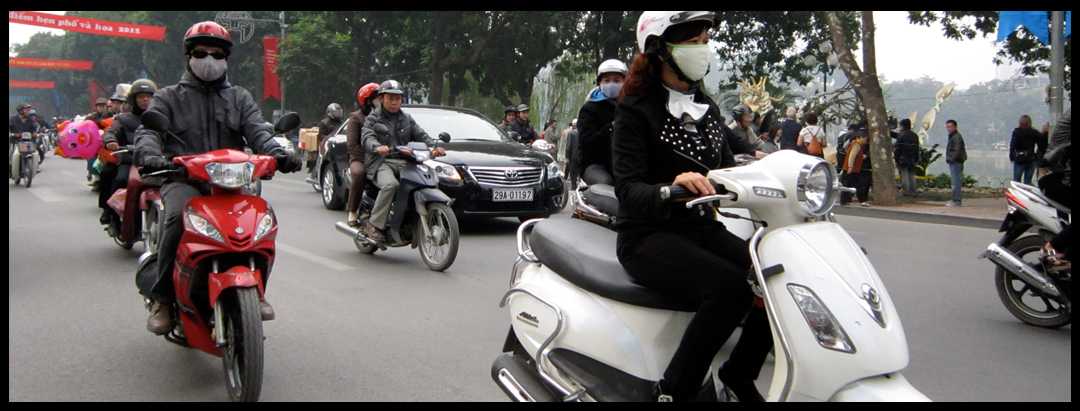Grace and beauty
It’s 7 am and the roads near the airport are full of densely weaving trucks, cars, mopeds, even people on foot – and once in the city itself, the rush hour doesn’t let up all day. There seem to be as many mopeds as people in Hanoi. The sky is dust laden, a kind of dry fog. It’s a miserable wet winter in the UK but here it’s warm enough to go without a coat. But not without a face mask, as we soon find out. The roads throw up plumes of red dust. In the streams of traffic, some women zoom by their bikes looking as if they’ve just left a fashion shoot, others protect themselves with an old over large tracksuit top worn back to front. Everything is carried on these bikes – we even see a live water buffalo tied to the back of one. There is a constant beeping of warning horns as vehicles, mopeds and bikes speed into minute gaps, an elaborately choreographed melee. We pass over the Red river – Sông Hồng – on either side of the highway, the former broad swathes of rice fields turned into huge factory complexes as far as the eye can see – producing all the electronic brand names we know so well in the West. Into the city and soon lost amidst a surprising array of old architectural styles strung together into a blur. The traffic is relentless, people coming and going all day along streets devoted to specific products – mannequins, plastic goods, paint, flowers, flags, plumbing, old carburetors, toys, silk scarves, laundry goods, Buddhist shrines (complete with flashing lights), print and stationary, recycled fridges and microwaves, all these things spilling onto the streets so you need to walk mostly in the gutters. This place somehow retains a semblance of old industrial ramshackle charm, despite the gleaming new factories sprouting on the outskirts. I recall Jane Fonda seemed to like it here, once upon a time. These days you can find a decent cappuccino and french pastry round the corner from Cua Bac Catholic Church.
Hue, Da Nang, Saigon, the names of these places, the highlands and jungles familiar to me from movies and newsreels, seen through the eyes of Don McCullin or Phillip Jones Griffiths or Larry Burrows, who were all here, providing images of this ‘long, polarizing catastrophe in Vietnam’ as Time-Life described it. In my teenage years Michael Herr’s ‘Dispatches’ and John Pilger’s ‘The Last Day’ seemed required reading for anyone with growing political consciousness. We see a film crew making a documentary about a retired Vietnam veteran, U.S. Army Col. Paul Longgrear. He was one of fourteen American survivors of the Battle of Lang Vei in 1968, the first time that the North Vietnamese used Russian tanks. With his the family, he was returning to the battlefield, meeting former enemy combatants. ‘They’re not so different to me, just old guys, except with worse teeth.’ He said he had found God on the battlefield, at the point where he was fully expecting to die.
Beyond Hanoi, north towards China, the climate and atmosphere changes, as we venture into mountains overwhelmed by fog and mists. We walk into the villages of the Black H’Mong, where our skin colour is marvelled at. One young woman says to us, “Your skin is so white. We would all like to have lighter skin. This is why we don’t like to go out in the sun so much.” But we rarely see the sun on these particular days in January, in this former French colonial hill station of Sa Pa, where water constantly runs off the hillsides and the homemade market moonshine called apple snake vodka helps keep the shivers at bay.
Here in 1913, a sanatorium was completed to house sick military officers and foreigners, the first tourist office opened in 1917, followed by the building of several villas to host top-ranked military officers. The long years of colonial rule by France has left its mark on the architecture across the north – it has a faded grace and beauty. But the result of the American war was that Vietnam was one of the poorest countries in the world and these border areas even poorer by Vietnamese standards, denied investment. Because the H‘Mong, a distinct ethnic group, had been recruited by the CIA to fight a covert war against the North Vietnamese and Communist Pathet Lao, suffering persecution ever since. They rely on natural resources for food, growing enough rice for their family for the year, though there is only one crop per year here and if there is bad weather life gets harder, so they supplement their income by selling handicrafts. There are several eco-tourist projects here, set up by Europeans and Australians, creating employment for local people, as there are few other opportunities, tourism now provides almost 60 per cent of local economic activity.
















